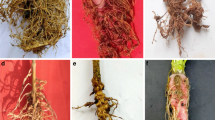Abstract
A study was conducted in Mississippi from 1995 to 1997 comparing soil rhizosphere fungi isolated from Pioneer 3167 hybrid maize (Zea mays L.) planted on Brooksville silty clay and Memphis silt loam soils. Maize seedlings were collected over four sampling dates from conventional and no-tillage plots. Eleven fungal genera consisting of nineteen species were isolated from these plants; Trichoderma spp. were most frequently isolated, followed by Fusarium spp. The highest disease incidence occurred in tilled plots of the latest planting date on Brooksville silty clay when samples were collected 17 days after planting. Root disease was most severe in 1996 from seedlings planted on the last planting date in tilled plots sampled 17 days after planting. Yields were significantly (P ≤ 0.05) higher on Brooksville silty clay soil than on Memphis silt loam in both 1995 and 1996. Yields were highest from no-tillage plots and from maize planted on the earliest date. There was a significant correlation between incidence of root infection and disease severity. There was no correlation between the incidence of root infection and yield or between disease severity and yield at either location.
Similar content being viewed by others
References
Anonymous. U.S. farmers choose environmentally beneficial growing system. Conservation Impact 1995; 13: 4.
Carter PR, Barnett KH. Corn-hybrid performance under conventional and no-tillage systems after thinning. Agron J 1987; 79: 919-926.
Allmaras RR, Burrows WC, Larsen WE. Early growth of corn as affected by soil temperature. Proc Soil Sci Soc Am 1964; 28: 271-275.
Futrell MC, Kilgore M. Poor stands of corn and reduction of root growth caused by Fusarium moniliforme. Plant Dis Rep 1969; 53: 213-215.
Mock JJ, Erbach DC. Influence of conservation-tillage and environment on growth and productivity of corn. Agron J 1977; 69: 337-340.
Olson TR, Schoeberl LS. Corn yields, soil temperature and water use with four tillage methods in the western corn belt. Agron J 1970; 62: 229-231.
Flore HH. Relation of environmental factors to growth and pathogenicity of Pythium isolated from roots of sugar cane. Phytopathology 1930; 20: 319-328.
Cook RJ, Boosalis MG, Doupnik B. Influence of crop residues on plant diseases. In: Crop Residue Management Systems. Am Soc Agron Spec Publ 31. 1978: 147-163.
Hornby D, Ullstrup AJ. Fungal populations associated with maize roots. Composition and comparison of mycoflora from genotypes differing in root rot resistance. Phytopathology 1967; 57: 869-875.
Mao W, Carroll RB, Whittington DP. Association of Phoma terrestris, Pythium irregulare, and Fusarium acuminatum in causing red root rot of corn. Plant Dis 1998; 82: 337-342.
Sojka RE, Busscher WJ. Conservation tillage in soybean and corn in the South Carolina coastal plain. Proc So Cons Till Conf, Tallahassee, FL, 1989: 46-48.
Sutton JC. Trichoderma koningii as a parasite of maize seedlings. Can J Plant Sci 1972; 52: 1037-1042.
Triplett GB, Dabney SM, Spurlock SR, Reinschmiedt LL. Management system for soil conservation and sustainable crop productivity. In:Wang SSY, Wang EJ, Langendoen EJ, Shields FD, Jr., eds. Proc Conference on Management of Landscapes Disturbed by Channel Incision, Oxford, MS: University of Mississippi Press, 1997.
Parris GK. A Revised Host Index of Mississippi Plant Diseases. Mississippi State University Misc Pub No 1. 1959.
SAS Institute. SAS/STAT User’s Guide. Release 6.03 ed. SAS Institute, Cary, NC, 1988.
Steel RGD, Torrie JH. Principles and Procedures of Statistics, Second edn. New York, NY: McGraw-Hill Pub., 1980.
Larson E. Corn Production: Planting Dates and Crop Development. Miss Coop Ext Ser Info Sheet 1997; 866.
Beeman CE. A Reference Unit on Corn. Mississippi State University Agricultural Education Department 1966; State College, MS.
Christensen JJ, Wilcoxson RD. Stalk rot of corn. Monograph No 3. American Phytopathological Society Press, St. Paul, MN.
White DG, ed. Compendium of Corn Diseases. American Phytopathological Society Press, St. Paul, MN 1999.
Windham GL, Windham MT. Effects of Trichoderma spp. On maize growth and Meloidogyne arenaria reproduction. Plant Dis 1989; 73: 493-495.
Kommedahl T, Windels CE. Root-, stalk-, and ear-infecting Fusarium species on corn in the USA. In: Nelson PE, Toussoun TA, Cook RJ, eds. Fusarium: Diseases, Biology and Taxonomy. University Park, PA: Pennsylvania State University Press, 1981: 94-103.
Farr DF, Bills BF, Chamuris GP, Rossman AY. Fungi on Plants and Plant Products in the United States. American Phytopathological Society Press, St. Paul, MN. 1989; 1252 pp.
Ochor TE, Trevathan LE, King SB. Relationship of harvest date and host genotype to infection of maize kernels by Fusarium moniliforme. Plant Dis 1987; 71: 311-313.
Young TR, Kucharek TA. Succession of fungal communities in roots and stalks of hybrid field corn grown in Florida. Plant Dis Rep 1977; 61: 76-80.
Harman GE, Chet I, Baker R. Trichoderma hamatum effects on seed and seedling disease induced in radish and pea by Pythium spp. Or Rhizoctonia solani. Phytopathology 1980; 70: 1167-1172.
Lewis JA, Lumsden RD, Papavizas GC, Kantzes JG. Integrated control of snap bean diseases caused by Pythium spp. And Rhizoctonia solani. Plant Dis 1983; 67: 1241-1243.
Mao W, Lewis JA, Hebbar PK, Lumsden, RD. Seed treatment with a fungal or a bacterial antagonist for reducing corn damping-off caused by species of Pythium and Fusarium. Plant Dis 1997; 81: 450-454.
Johnson B, Brock WA. Tillage systems for corn production. In: Research Progress Report Miss Agric For Exp Stn Info Bull 1991; 202: 48.
Dick WA, VanDoren DM. Continuous tillage and rotation effects on corn, soybean and oat yields. Agron J 1985; 77: 459-465.
Griffith DR, Mannering JV, Galloway HM, Parsons SD, Richey CB. Effect of eight tillage-planting systems on soil temperature, percent stand, plant growth, and yield of corn on five Indiana soils. Agron J 1973; 65: 321-326.
Author information
Authors and Affiliations
Rights and permissions
About this article
Cite this article
Soonthornpoct, P., Trevathan, L., Gonzalez, M. et al. Fungal occurrence, disease incidence and severity, and yield of maize symptomatic for seedling disease in Mississippi. Mycopathologia 150, 39–46 (2001). https://doi.org/10.1023/A:1011032801808
Issue Date:
DOI: https://doi.org/10.1023/A:1011032801808




